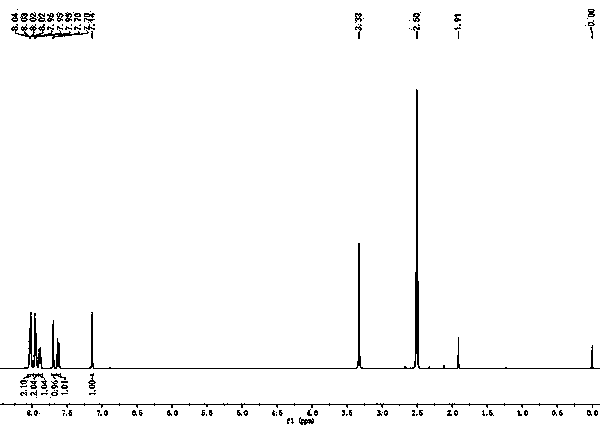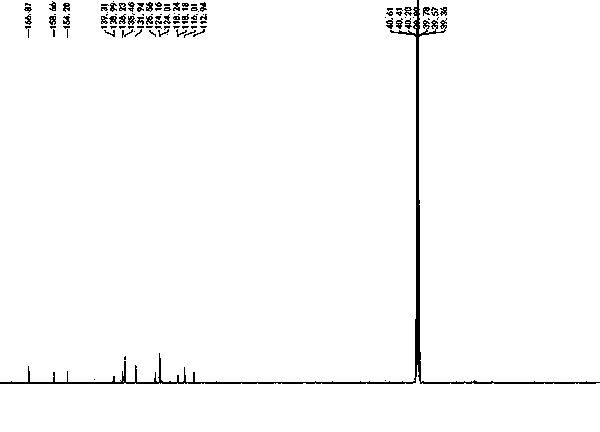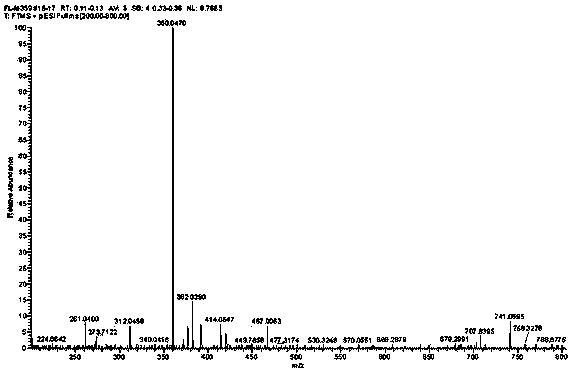Specific fluorescent probe for identifying hydrazine and application thereof
A fluorescent probe, specific technology, applied in fluorescence/phosphorescence, luminescent materials, material analysis through optical means, etc., can solve environmental pollution and other problems, achieve simple and easy synthesis process, cheap and easy-to-obtain raw materials, good fluorescence The effect of the characteristic
- Summary
- Abstract
- Description
- Claims
- Application Information
AI Technical Summary
Problems solved by technology
Method used
Image
Examples
Embodiment 1
[0020] The chemical synthesis of embodiment 1 fluorescent probe
[0021]
[0022] Put 1 mmol 4-trifluoromethyl-7-aminocoumarin, 1.1 mmol phthalic anhydride, 2 mmol sodium acetate in a 25 ml two-necked bottle, add 10 ml acetic acid, reflux at 110°C for 48 hours, and depressurize The solvent was distilled off, the residual solid was washed with water, and filtered to obtain 112 mg of a light yellow solid as a fluorescent probe. For the characterization results of the fluorescent probe, see figure 1 , figure 2 with image 3 .
Embodiment 2
[0023] Embodiment 2 For the selectivity of different substances
[0024] (1) Prepare 99 μl metabolic reaction system in advance, including PBS buffer (10 mM) at pH 7.4: DMSO (volume ratio 1:9), fluoride ion (100 μM), chloride ion (50 μM), bromide ion (100 μM), Iodide ion (100μM), sodium ion (100μM), potassium ion (100μM), calcium ion (100μM), magnesium ion (100μM), nitrate ion (100μM), hydrazine (100μM)
[0025] (2) Add 1 μl probe with a final concentration of 10 μM to the reaction system to initiate the reaction;
[0026] (3) After 40 min, perform fluorescence detection; calculate the fluorescence intensity in each system (see Figure 4 ).
Embodiment 3
[0027] Embodiment 3 linear relationship with hydrazine concentration
[0028] (1) Prepare 99 μl metabolic reaction system in advance, including PBS buffer (10 mM) at pH 7.4: DMSO (volume ratio 1:1), hydrazine (0-200 μM), and react at 37°C for 40 minutes;
[0029] (2) Add 1 μl probe with a final concentration of 10 μM to the reaction system to initiate the reaction;
[0030] (3) After 40 min, perform fluorescence detection; calculate the fluorescence intensity in each system, and establish a standard curve of fluorescence intensity and hydrazine concentration. The standard curve is y = 762.68x + 1845.5, R2 = 0.9973, where y represents the fluorescence intensity at 496 nm The ratio of the fluorescence intensity at 450 nm, x represents the concentration of hydrazine (the linear relationship between the concentration of hydrazine is satisfied between 1 uM and 150 uM) (see Figure 5 ).
PUM
 Login to View More
Login to View More Abstract
Description
Claims
Application Information
 Login to View More
Login to View More - R&D
- Intellectual Property
- Life Sciences
- Materials
- Tech Scout
- Unparalleled Data Quality
- Higher Quality Content
- 60% Fewer Hallucinations
Browse by: Latest US Patents, China's latest patents, Technical Efficacy Thesaurus, Application Domain, Technology Topic, Popular Technical Reports.
© 2025 PatSnap. All rights reserved.Legal|Privacy policy|Modern Slavery Act Transparency Statement|Sitemap|About US| Contact US: help@patsnap.com



